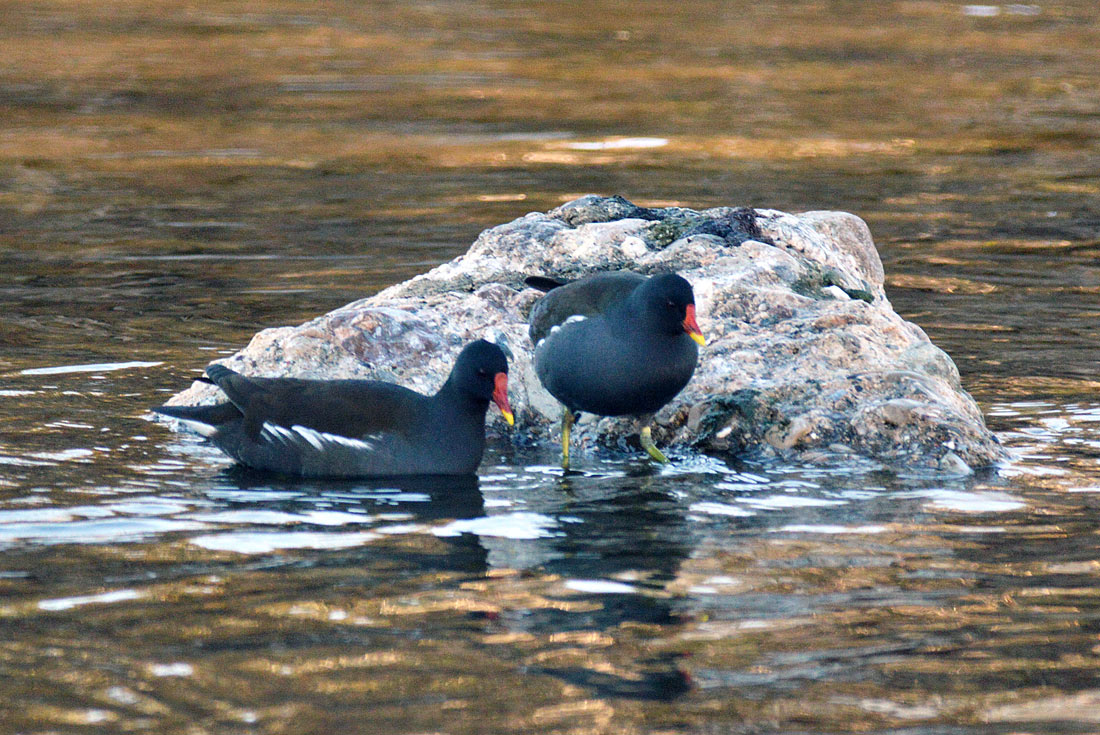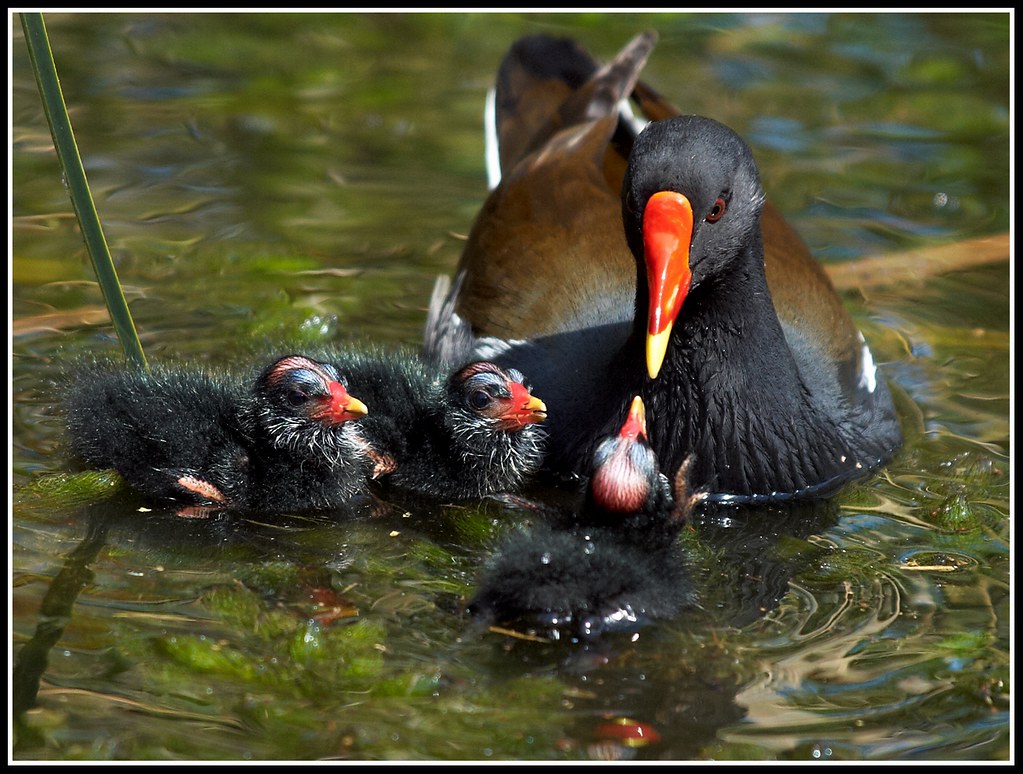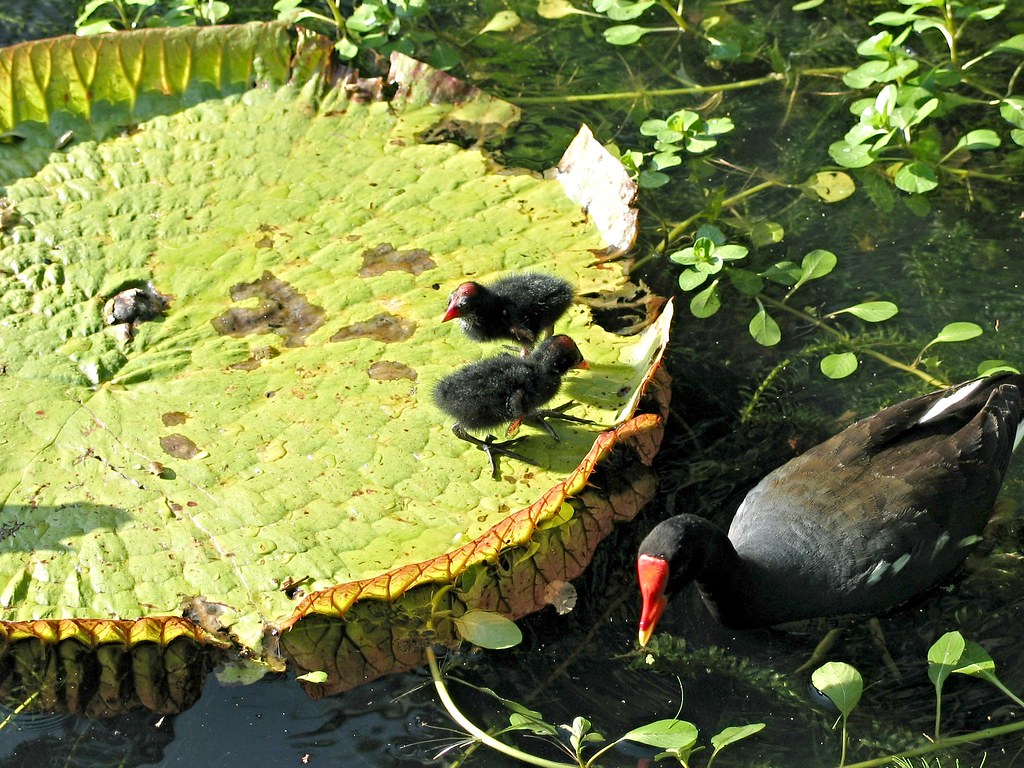A species of bird that is very similar to the American Moorhen is called moorhen and it has a slightly different behavior from that of this species, in this post we will delve into its characteristics, the subspecies found, its feeding, behavior, its habitat, its form of reproduction, among other things.

Moorhen
The moorhen is known as redfish Common, its name corresponds to its genus: Gallinula and its species: Chloropus. It is one of the smallest guirform birds of the rails according to Carlos Linnaeus who described a moorhen for the first time in 1758. Although it was believed that it belonged to the same species as the American moorhen, since it had quite similar physical characteristics and Only a few differences could be seen in their beak and the sound they made when singing.
subspecies of the moorhen
After both species were generically analyzed, it was discovered that there were more differences between the two, at the same time subspecies of this moorhen were discovered as time passed. It must be taken into account that just as subspecies of the moorhen have been discovered, some have also disappeared due to all the environmental problems observed. There are fifteen known subspecies and they have the following scientific names:
- Gallinula chloropus: In the following locations they can be found: Burma, Kashmir, China (in the south and east), Hainandao, in India, Iraq, Japan, Malacca (in the north), in the Arabian Peninsula (in the south), Sri Lanka , Taiwan and Tibet (to the south).
- Gallinula chloropus barbadensis: This subspecies together with the Gallinula chloropus seychellarum they are still under observation because they are physically very similar, the barbadensis were seen in greater numbers in Barbabos - Caribbean Island and the seychellarum in Seychelles - East Africa. Barbados moorhens were discovered in 1954.
- Gallinula chloropus cachinnans: These birds currently inhabit North and Central America, specifically in the Bermuda, Galapagos and Bahamas islands. The first time they were seen was in 1915.
- Gallinula chloropus cerceris: The birds of this subspecies are found in a group of islands that are north of the Caribbean Sea (Greater Antilles), also southeast of these islands (Lesser Antilles, east of Puerto Rico). His discovery appears to be from the year 1910.
- Gallinula chloropus galeata: They were seen for the first time in the year 1818, which places them as the oldest subspecies found. Their current locations are: Argentina (in the north), Brazil, Bolivia (in the east), Guyana, Paraguay, Trinidad, Uruguay and Venezuela (in the north) are the countries in which the moorhens that belong to this species live. subspecies.
- Gallinula chloropus garmani: It is possible to see birds of this subspecies discovered in 1876 in Argentina (in the northwest), in Bolivia (in the east), in Chile (in the north) and only in the highlands of Peru.
- Gallinula chloropus guami: Guami moorhens inhabit the Mariana Islands and were first seen in 1917.
- Gallinula chloropus meridionalis: This is the subspecies of the moorhen seen in Africa, specifically in the Cape Province and on the island of Santo Tomé, although some were also seen on the island of Annobón, its year of discovery is 1821.
- Gallinula chloropus orientalis: As for the moorhens of this subspecies, the locations can be recorded as their habitats: Bali, Borneo (specifically in Kalimantan), Flores, Java Island, Kangean, Lombok, Malacca (in the south), Sulawesi and Sumatra.
- Gallinula chloropus pauxilla: These fowl pullets were seen in the north of Colombia and to a lesser extent in the west of this same country, they are also found in Ecuador (in the west) and in Peru (in the northwest).
- Gallinula chloropus pyrrhorrhea: It was seen in Madagascar and Mauritius, the first time it was seen in 1861.
- Gallinula chloropus sandvicensis: In 1877 the first moorhens of this subspecies inhabiting Hawaii were seen.
Features
Regarding its appearance, the first thing that can be said is that it measures between 27 and 38 centimeters, which makes it quite visible, however, when they open their wings they can cover up to 62 centimeters. In addition to that, it weighs between 192 and 500 grams, generally the males are the ones with the largest measurements compared to the females.
Its color is not very varied unlike the Parakeets which have as many colors as subspecies and even more, a moorhen is generally dark gray almost black, its entire head and neck have a darker hue than the rest of its body, in fact in the lower part of his tail can be seen a white color.
As for its triangle-shaped beak, its particularity is its largely red color, with the exception of the tip, which has a fairly bright yellow color. It is the beak that notably differentiates it from the American moorhen. However, its legs are yellow with a greenish hue and two red spots found on each of the knees, it should be noted that they are long compared to other rail species.
Likewise, their fingers are long, which helps them to move easily on some aquatic plants. As well as slightly curved claws that have a yellow color with green tones. As for its tail, it is short and as indicated it has a white color on the bottom, although gray feathers can also be seen.
It is possible to notice changes in their appearance as they grow, an example of this is how younger moorhens have a brown body and a neck so light that it can almost be white. When they are older, a red stripe may appear on each thigh and their beak will have a red that will be more intense as it appears, the yellow color of the tip is also quite striking.
But not only in their beak do they have a red color when they reach maturity (since when they are young they have a greener beak with brown than red). The eyes also have red although their pupil is black, when they are young their eyes are brown and then they change color. Females and males are actually the same except for the size difference mentioned above.
Its tail, as indicated, can be black but not as dark as the bird's head and neck, it can also be white on the inside or gray, the truth is that they are short and have white striped flanks. Their tail seems to move with the rhythm with which they usually swim because they tilt it at the same time as they nod their heads throughout their swim.
Behavior
Socially these birds tend to avoid other communities of other species at all costs and even the same moorhens, in fact when they travel they usually settle in the same place for a short time up to twenty pairs of this species and even so they stay away from each other with one or five meters of distance. They really tend to stay in pairs and even alone, scaring away strangers with quite high-pitched whistles.
In this sense, their behavior towards other species when there is a conflict is quite aggressive, they often fight with other species of birds. As for their behavior against predators, these birds, when they perceive that one of them is approaching, flee to the shore and hide there until they feel safe again. They can flee by swimming, diving or flying, although this is not very common. When the predator comes by air or they are human they dive like all sea cock.
Its song on the one hand is quite short and even agitated, often used by mothers to call their young. The song that is heard when they are in danger is different, as well as those that they emit when they feel afraid. As for the one that all birds emit on one occasion or another during the day, this usually sounds like a whistle.
When they are just born they begin to make sounds like short beeps very soon after leaving the egg, when they grow the sound becomes more strident and noisy when they flee from something. This is until they die, which is usually until they are eight or twelve years old.
Foodation
As for their diet, this is quite extensive because they are omnivorous birds, they eat a large amount of vegetables of many types such as seeds, pieces of aquatic plants, herbs, swamp plants, as well as some small aquatic invertebrate animals and molluscs. , in addition to insects and mussels, that is, their food is found in and out of the water, due to their variety they do not have great difficulties in feeding.
Like other birds that swim in ponds, lakes, rivers, etc. the moorhens submerge almost completely to be able to catch these small water animals, when they are eating out of the water they can be a bit shy but they easily find their food and in the end they end up looking for it, in fact when dead fish are left out of the water moorhens tend to peck at them and they are not the only corpses that peck, also from other birds.
Other things that they usually eat are snails, dragonflies, spiders and beetles, they have also been seen eating the eggs of other birds. In any case, it is the males that usually eat in greater quantity than the females because at the time of courtship those that look more robust show the females that they are the most suitable for raising young and defending the nests.
Reproduction
Their courtship is really long if it is considered as a dance or ritual, the first thing they do is show their tail feathers, then they proceed to fold them and you can also see how they peck them to then mate, it may seem simple but it actually takes a long time. little to do. As for the time in which they do it, this is usually from the beginning of October to December. The usual thing is that it is the females who choose a partner and these usually come with the other migratory birds.
Another part of the courtship that was not mentioned is the one that takes place on the surface of the water, this can be as follows: the male approaches the female swimming and pecking the water on the surface, in some cases the females move away them and that makes them float around them and simulate that they continue to peck at the water. Then it is that they chase them and they do so repeatedly until they no longer leave distance between one and the other.
Once they are formed as a couple and the reproduction in birds It is the males who look for the right places to make the nest, this can be in other countries such as those in central Europe. They make quite elaborate nests (they can even build two nests and then they stay with one of them) these have several platforms or layers (there can be up to five) and after they are armed they occupy them to sleep together with the eggs.
The males, in addition to being the ones that locate the best places, are the ones that build the nest, although it is not only them, the females also generally collaborate by lining them. They only consider the nests finished when the first laying of eggs is about to take place and even during their incubation, when they are there what they usually do is place green plants in the form of a canopy as a method of protection against the thieves of the nests. bird eggs.
Moorhen pups
The females usually begin to deposit their eggs at night (between 7 pm and 10 pm) when the month of April is already halfway through, this is what has been observed in Europe. These eggs are yellowish brown or beige with gray tones, they can even have darker brown or purple spots to the point of being confused with black, their shell is really firm so they weigh approximately 20 grams.
In addition to that, females usually have up to three clutches, only they do not have the same number of eggs as the first. They stay in the nest 19 or 22 days into their incubation period and are incubated by both parents, after that you start to see cracks in their shells (even two days before they are actually going to come out) and to leave can take between 2 and 18 hours.
As for the time it takes for them to leave the nest for the first time, this can take one or three days. They can swim almost from the first day of birth and can dive at five days, at ten days of birth they usually look for their food themselves. All this under the care of their parents, since both actively participate in their care and upbringing.
Their young look different from the one they acquire when they are adults, as soon as they are born their beak is red, almost orange, although its tip remains yellow. As for its plumage, it is black with greenish tones on the back, on the part of the bird's chin you can see a white color as if it were dirty. However, all that plumage does not stay the same color.
skillstat
This bird was seen for the first time in Eurasia and then they were seen in the African continent, it is very easy for them to be distributed in several countries (as can be seen in the location of the subspecies found) but they must have humid places such as rivers, lakes , ponds, reservoirs and even swampy areas, this type of ecosystem is found in many countries around the world and that is why this water hen It is known in many places such as Poland, southern Finland, among others.
These birds are really very calm as could be seen in the description of their behavior, that is why many moorhens are visible to people in natural parks, zoos, public ponds, water dams, reservoirs, ditches, among others. others. In fact, they have also been seen in places where the water is not completely natural, places with contaminated water resulting from the dirt produced by the cities of the countries in which they live.
What is really necessary for them to be comfortable is that there is smooth running water and it is surrounded by swamps and mud, as well as a large vegetation so that it resembles that of the places of their habitat described above. Moorhens can really be located in various places with those descriptions that have a temperate, mountainous and even arid climate, their preference for swimming and their type of habitat are the things that make this type of bird have the name Moorhen. Water.
Currently the place where they are found in greater quantity is in the Canary Islands, in places such as Gran Canaria, Gomera, Aracuas, Teror, San Lorenzo, Tenerife, Maspalomas, among others. This is where the largest number of moorhen pups occurs compared to the other countries where it has been seen and each of these locations have the characteristics of their preferred habitat.
It should be noted that, like other Endangered animals in the world these birds have lost a considerable part of their natural habitat and that is why they migrated to other countries, reproduced more and are so well known and even common on the planet, this was very beneficial because they are not in as much danger of extinction as other species that they did not have can reproduce in large numbers, that they are hunted or that they do not adapt so well to other places.
Other countries to which they have migrated include England, the Shetland Islands, Norway (to the south), Sweden (to the south), Saint Petersburg, Siberia (to the south), Altai (to the west), Dsungarei, Kashmir, Tourestan, Brutareal (to the south), Morocco, Sahara (to the west), Libya (in the northeast), Nile Delta, Israel, Lebanon. Also in central regions of Germany and in the east of this country, the Netherlands, Belgium and even in France, which is where they stay during the winter.
In Spain they also have a great presence, these birds are seen very often in Spanish archipelagos and peninsulas that are surrounded by swamps, large trees and mountains. Something that may seem different from everything explained is that the moorhen usually reproduces in places far from the sea up to 1800 kilometers above its level (which was the highest limit recorded), Spain has been a great nest for this species to reproduce in large numbers and also a starting point for your migration.
Many of those that are seen in the countries near Spain were born in this nation and then they were distributed to other places, these trips have not been a big problem for the moorhens because their ability to adapt is really great, no they have been so affected by the structural changes that have come with the evolution of the human being. Italy is another nation to which they travel often but it seems that they prefer the habitat of this country when it is time to hibernate.
There was talk of migration because this species is really migratory in itself, they keep moving although they can spend some time stationed in one place. It should be remembered that these places where they are kept for a longer amount of time must have shallow water and a wide variety of vegetation around, on the water there may also be floating leaves on which they can walk. In any case they can enter a garden of human houses if there is enough water in it.





